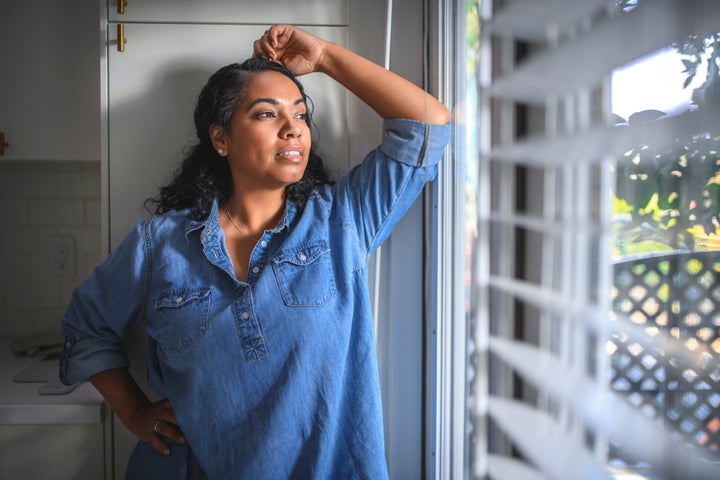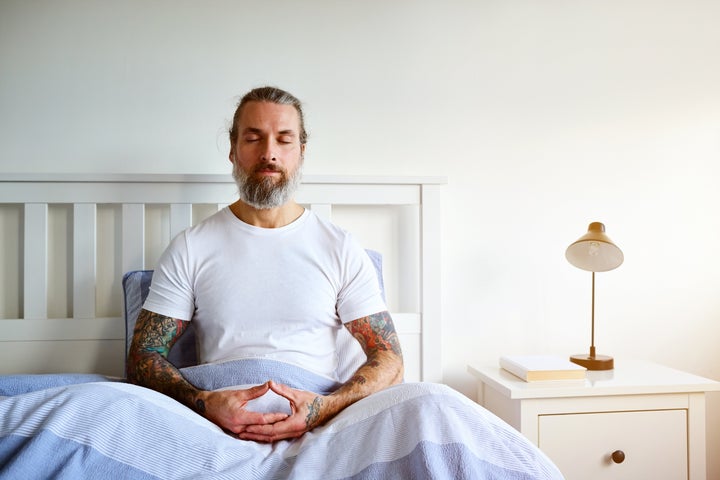Freddie Francis, a lifeguard manager on a cruise ship, was returned home to Orlando, Florida, after enduring a 14-day lockdown on a voyage that was supposed to end at a port in Sydney. That changed after four crew members tested positive for COVID-19.
During and shortly after the lockdown, temperatures were taken twice a day — at 10 a.m. and 5 p.m. Food was delivered to crew members’ doors and left on nightstands placed outside.
Many of the crew members were moved into guest cabins to make them more comfortable, as the crew cabins were below deck and windowless.
Francis was in a crew cabin for two days before being moved to a guest cabin with a porthole, which allowed him to see the world outside as the ship floated aimlessly in open waters. Toward the end of the lockdown, Francis was able to move to a room with a balcony — and he felt thankful for the fresh air and warm sunlight on his skin.
“They tried to accommodate us as best they could,” Francis told HuffPost about the cruise company.
During the lockdown, Francis tried to focus on the things within his control, as opposed to the many things that weren’t — such as when he could go home.
“I would eat my dinner cold because I would force myself to do a workout before I ate,” he said. He recalled working out nearly every day, adding that it helped with his mental clarity and mood. On the days when he struggled and skipped a workout, he would work out twice the next day.
Francis also picked up a copy of “Can’t Hurt Me” by David Goggins, a man who went on from an abusive childhood to become a Navy SEAL, an ultra-endurance athlete and a world-record holder. He watched movies, played video games, talked to friends online when the Wi-Fi worked and checked in on the lifeguards who worked with him.
Francis said he had a few people he vented to as well. He decided against calling to ask for updates, though, as the captain was already sharing the information he had as soon as he had it. And there was no point in asking questions that didn’t have answers yet.
He had to radically accept that he was stuck on this boat for the time being — without knowing when or how he would get back home to Orlando. That radical acceptance is what allowed him to problem-solve in a way he wouldn’t have been able to otherwise had he continued to fight reality.

What Is Radical Acceptance?
Radical acceptance is “letting go of the struggle with reality and allowing reality to be just as it is,” said Antonia Pieracci, a clinical psychologist and founding partner of Cognitive Behavior Therapy Associates of Denver. “It’s total and complete acceptance with the mind, body, heart and spirit.”
Pieracci’s clinic treats depression, anxiety and insomnia, using evidenced-based treatments. One of those treatments includes dialectical behavioral therapy, which uses cognitive and behavioral strategies to help patients combat destructive or unhealthy behaviors. One of the main strategies of the process is learning about and working toward radical acceptance.
Radical acceptance can best be summed up by this example, said Randy Wolbert, a DBT clinician and Zen teacher based in Michigan:
You go to look for your car keys on your kitchen counter. They’re not there. You scour the house for them, but keep coming back to the same place where you always put them — the kitchen counter — even though you already looked there. That is non-acceptance. Eventually, you accept the fact that they are not where you ordinarily put them. You think through your last steps when you put them down, and you find your keys. That is radical acceptance.
That doesn’t mean you stop feeling whatever emotions you’re having about that reality. It simply means you acknowledge what has happened, and as a result, you’re able to move forward.
Radical acceptance is actually something that can help anyone, not just those working through a clinical diagnosis with a therapist. It’s especially relevant during COVID-19, as many of us struggle to accept a new reality in our lives: the loss of control, the loss of a loved one or the loss of our financial resources.
You Don’t Have To Like Reality To Accept It
People often hear the word “acceptance” and equate it with approving of the situation, Wolbert said. That’s not the case. Acceptance is more about letting go of your attachment to your desired outcome and accepting life just as it is in this moment. Once you accept reality for what it is, only then can you focus on the changes you need to make, which are within your control
“I can have a preference,” Wolbert said. “There’s a lot of times I have a preference. But the acceptance piece, the freedom piece, comes from letting go of having to have it.”
Maya Rogers, a 27-year-old in Orlando, knows the feeling of moving from suffering to acceptance. She and her fiance waited until the last minute to decide to move forward with their April 4 wedding — except without the guests. She put off the decision until two weeks out, hoping that the COVID-19 situation was going to improve.
“Every single week it was a new realization of, ‘Oh, this isn’t going to change. Oh, things are getting worse. We need to do something and make a decision.’ But we also still kind of battled just not wanting to face facts,” Rogers said.
When she realized she was either going to have to cancel her wedding or have a very different version of it than the one she’d planned for a year and a half, she burst into tears.
“It was difficult that day when I made the call to my family,” Rogers said. “I’m not a very openly emotional person, and I just cried. I was at work, and I just cried. I think it just was that release. I knew it was inevitable. I knew that it was coming, and it finally all just bubbled up.”
That moment was both her breaking point and her tipping point. When someone has a sudden shift into radical acceptance, there can be intense grief and pain, Pieracci said. After that, she added, there can be some relief and some ability to move forward when someone might have been stuck before.
The couple held the wedding ceremony on a nature path Rogers had found one day while hiking. The night before, she and her fiance decided to write their own vows. She wouldn’t have been willing to do that if they had had the big wedding they originally planned because of her shyness.
“It was just relaxed, special and honestly better than I probably could have imagined,” Rogers said.
Radical Acceptance Can Help Us Cope With Anxiety And Loss
At the beginning of the pandemic, Jennifer Billock, a 36-year-old living in Chicago, was having panic attacks nearly every day as a result of a generalized anxiety disorder and panic disorder. That anxiety eventually calmed to a simmer, she said, before ramping back up after her great aunt died from health problems unrelated to COVID-19.
Things got more difficult when Billock found out that an in-person funeral would take place, but that only 10 people could be in the room at a time. “We could have gone, but we didn’t want to take away from time the immediate family was going to be able to spend together,” she said.
Family members who were unable to attend the service in person were able to watch it online via livestreaming video. Watching the funeral online was difficult for Billock, as she could hear the voices of her family members but couldn’t offer them a hug or be there to cry with them.
Billock said she eventually accepted that she couldn’t be at the funeral because of the health risks right now. But she and her mom are still in disbelief at her great aunt’s passing.
Radical acceptance is actually an effective way to cope with grief and loss, Pieracci said. She added that each of us experiences different types of loss in the face of the pandemic. The only thing you can control is how you choose to respond to them.

Small Practices You Can Do To Help Cultivate Acceptance
Radical acceptance is more experiential than cognitive, Wolbert said. It’s also not a passive experience. It takes practice. He suggested trying a daily meditation and being aware of the “shoulds” that come up, which is often indicative of non-acceptance. Then tell yourself, “Yeah, I’m having a thought that things should be different. This is what is.”
Pieracci also outlined a practice that she encourages her own patients to follow: Start by creating a statement of acceptance for yourself. Maybe your children are home more during the pandemic, and you’re also working full time. Your statement might be as simple as, “My kids might interrupt me during this work call.”
Repeat your statement of acceptance aloud or to yourself. Allow whatever emotions are present to be there. Repeat that statement in a calm tone of voice. After a couple of moments of doing that, come out of the exercise.
Caveats To Radical Acceptance
Like anything, there are limitations to the practice. Sometimes it can be difficult to distinguish the difference between true reality and an alternative version of it you may be telling yourself.
For example, if someone’s life and well-being was at stake, as in an abusive relationship, you wouldn’t want them to radically accept their situation and stay, Pieracci said.
In that case, the reality that may need to be accepted is that the abuser won’t change — and that you deserve to get out of the situation immediately.
Radical Acceptance Isn’t A Destination
What determines whether someone accepts reality or fights against it? It comes down to accepting life as it comes with open palms or refusing it with clenched fists.
“Willingness is that whole idea of being open to participation,” Wolbert said. “Open to full participation and whatever comes. Willfulness is actually much more sitting on your hands. It’s like, ‘I shouldn’t have to deal with this.’”
Wolbert added that acceptance is a constant journey, not a permanent residence. You can start in a place of non-acceptance and then experience acceptance. The opposite is also true. One day you might accept the fact that you lost your job, and the next day, go back to thinking, “Why me?” It’s a continuous journey, and you have to continue to turn down the road toward acceptance.
“Sometimes people have to get to a point where they realize that what they’re doing isn’t working,” Pieracci said. “They have to see that and decide that for themselves. Other people can suggest that, but they have to know that for themselves. And be willing to face the uncertainty of trying something new, which may be uncomfortable.”
Pieracci said it sounded as if Francis, Billock and Rogers were all able to see their situations accurately, make the most of them and move forward with what was important.
Any time you come to any level of acceptance, Wolbert said, there’s a sense of peace that comes along with it. That’s what makes the journey worthwhile.
“You have to keep practicing acceptance,” Wolbert said. “And so you can certainly observe that you’re not at acceptance yet. And that means, I’ve got work to do yet.”
This story is part of HuffPost Life’s series on coping with uncertainty during the coronavirus pandemic. Check out our other stories below.
A HuffPost Guide To Coronavirus
Credit: Source link